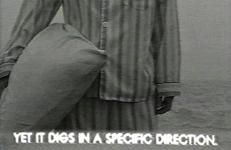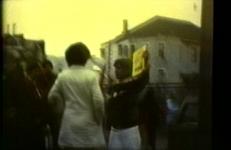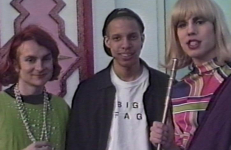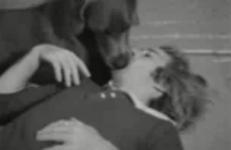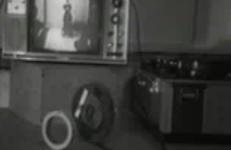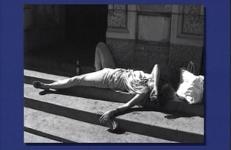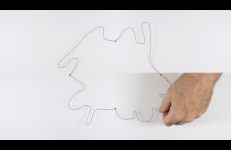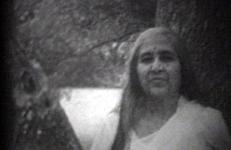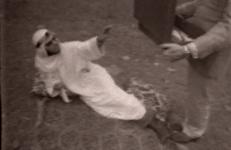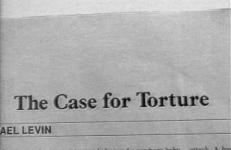Richard Schechner is Professor of Performance Studies at New York University, author of numerous books including Performance Theory (1988) and The Future of Ritual (1993), and editor of The Drama Review. This interview with Nancy Forest Brown was conducted during an event at the School of the Art Institute of Chicago.
Performance
Taking its title from a poem by Paul Celan (translated as “sleeping den”), this montage is the result of a script that reconfigures over two hundred lines of English subtitles, lifted from films ranging from Battleship Potemkin and Persona, to The Bitter Tears of Petra Von Kant. The disconcerting soliloquy on love and insomnolence is deliberately attempted in the original French, German, Russian, Italian, and Swedish.
Originally part of a larger sculptural installation using prospector's tools, this tape reenacts the search for "Olga," a miner's wife who disappeared on her honeymoon in 1936. As Paul and Marlene Kos call out, "Olga... Olga...", the camera scans the Wyoming wilderness, and their search becomes ritualistic, the repetitive calls building in intensity and breaking down into chanted moans.
A series of one-minute interview-based spots Martha Rosler made with the American Indian community during her residence in Seattle from 1991 to 1995. Rosler reveals lost languages, unrecognized tribes, and the experiences of contemporary Native Americans living not on reservations but in the city.
A Second Quarter is decidedly European; the “place” (Berlin) is the catalyst for the “action” (the work). The works recited in the film are concerned with barriers and borders, physical and geophysical phenomena. The characters also translate, count, and recite the alphabet. They build a narrative that is not a story to be followed dogmatically but rather a pattern from which to extract one’s version of what is seen.
Reading the billboards, the cars, the people, and the graffiti of the street as cultural signs, Rosler extracts the network of social power and domination that determines whose culture gets represented where, asking whose culture is reported in the press and whose is forced to exist in the street?
In this episode of The Brenda and Glennda Show, Brenda and Glennda lead a group of drag queens on a trip to Donald Trump’s Taj Mahal Hotel & Casino in Atlantic City. Intended to be a drag queen gambling getaway and a public stage for drag visibilty, the trip turns into a moment of protest and reflection incited by homophobic discrimination. The group is kicked out of the gambling area for supposedly wearing excessive makeup and inapprorpiate, flashy attire — somehow unlike and worse than that of the casino's showgirls and other heavily powdered female patrons.
Re-mastered in 2005, Reel 2 features a series of demonstrations and durational tests: how to protect oneself from germs; how to turn a roll call into a role play; and an excruciating exercise in desire, as Man Ray attempts to get his just rewards. While entertaining, these humorous pieces also parody television culture and work to highlight issues of consumerism.
Contents:
Sanforized, 0:47
Coin Toss, 2:11
Monkey Business, 1:06
Same Shirt, 0:32
The works on Reel 3 were produced during 1972-73, and re-mastered in 2005 when several newly available titles were added. The focus here is on social relationships and attaining the perfect life, be it through making the right decision, getting something for nothing, or just having it all. Many of the comic skits parody television ads and infomercials, and Man Ray has to make some consumer choices.
A newly re-mastered collection of 22 comedic performances to camera, produced during 1973-74. Absurd stories mix with word play; product demonstrations extol the virtues of a specially modified cocktail tray or canine selling aid; and throughout it all, Man Ray. May Ray woken by an alarm clock, tormented by paper-throwing and map-reading, and ever attempting to understand his master.
Contents:
Wake Up, 1:33
Trip Across Country, 0:50
Down Time, 0:36
Laundromat, 0:43
A newly re-mastered collection of 17 vignettes and performances to camera, produced during 1974-75. Some use props and sight gags to preposterous effect; others star Man Ray, lapping milk from a glass, stopping marbles and dropping balls. Many of the pieces feature off-screen dialogue, including a comparison of the differences between audio- and videotape, and video and film.
Contents:
Nocturne, 7:49
Stalking, 2:06
Audio Tape and Video Tape, 2:04
Dancing Tape, 5:27
Originally recorded during 1975-76 and re-mastered in March 2005, this selection of 11 skits mostly focuses on Man Ray. Wegman appears to test his faithful friend, continually throwing a ball for him to catch even after the dog loses enthusiasm; playing with a cardboard tube which intermittently emits a loud sound recording, alternately attracting and repelling the dog; pulling a cord attached to his leg while making him “stay”. Wegman also take a leap into the world of color with special effects and a monolog about furniture. Includes:
Originally made during 1976-77 and re-mastered in March 2005, this selection contains a mix of visual jokes, conceptual humor and performance. Wegman "dialogs" with himself, close-ups of his mouth and teeth taking on different characteristics and voices; remakes of earlier black and white performances; and man and dog in focus, including a failed attempt to induce Man Ray to smoke.
Alarm Clock, 0:30
Doctor Patient, 2:20
Bad Movies, 2:00
Drop, 0:43
Fruit, 0:25
Smoking, 1:55
Horseshoes, 1:10
Fast, 0:15
Concerto, 1:20
From A to Z in this mock cooking-show demonstration Rosler 'shows and tells' the ingredients of the housewife's day. She offers an inventory of tools that names and mimics the ordinary with movements more samurai than suburban. Rosler's slashing gesture as she forms a letter of the alphabet in the air with a knife and fork is a rebel gesture, punching through the 'system of harnessed subjectivity' from the inside out.
"I was concerned with something like the notion of 'language speaking the subject', and with the transformation of the woman herself into a sign in a system of signs that represent a system of food production, a system of harnessed subjectivity."
— Martha Rosler
This tape addresses spiritual closure. Video gave me a chance to examine, see, and celebrate the seven spiritual venues, paths, and journeys that I have made: 1) Catholic life, 2) nun's life, 3) yoga life, 4) Buddhist life, 5) feminist life, 6) natural life, 7) life. Publicly, I am admitting that I am a spiritual materialist—been there, done that—but I am also saying that all of my spiritual experiences have worked together to prepare me for even deeper journeys combining all of the sacred technologies I have learned so that I can re-invent my own way.
This tape functions on two levels. Montano addresses menopause and acts out her worst nightmares around that issue—playing the out-of-control, alcoholic crone. By doing this publicly on tape, she felt that she could look at, share and make friends with, her concerns with aging. The experience of viewing this video moves from an autobiographical look at Montano’s process to an interactive game for the viewer.
Shape Games is a film about play, abstraction, and enchantment. A series of strange and seemingly pointless activities unfold. Line drawings morph and shuffle; bottles of water are inverted and spilled, small rocks scrape across the ground; larger ones tumble across a rain drenched hill; wires bend; droplets are smeared across walls, paintings, and screens; cameras are chased—to the point of exhaustion. And a woman speaks. She describes strange things, chimeras and hybrids, objects and creatures, buzzing metamorphoses.
In 1991 Montano met a Hindu couple at Ananda Ashram, the meditation center she attends in upstate New York. Since then, the three have become friends. Mr. and Mrs. Mehta are Ayruvedic doctors; both physically resemble another Indian couple—saints Sharada and Ramakrishna, who lived in Calcutta in the 1800s—and are both known for their incredible devotion to the mystical life. Montano made this postmodern documentary to honor the Mehtas, to present an idealized model for a spiritual relationship and to hold out the possibility for spiritual ecstasy in everyday life.
A pro-domme gives her friend a freshly shaved head. In return she gets a buzz cut. A client gets to be a (bound) fly on the wall.
This title is also available on Chicago Sex Change: 2002-2008, A collection of Minax's early videos that together create a punk-documentary tapestry of young queer life in Chicago in the early 2000s.
In this spoof program produced for Lanesville TV, the premise is that a “Sheik” has come to buy all the land in Lanesville. Videofreex member Carol Vontobel reports that the sheik (Bart Friedman), escorted by his real estate agent (Parry Teasdale) is approaching people in the community and asking to buy their homes. An unknown Lanesville local chauffeurs them around, and the Videofreex interview Mr. Benjamin, Mr. And Mrs. Kelly, Mr. Lloyd, Mr. and Mrs. Ginsburg, and others from the Tavern.
This flashy drama about theater life was made with my students at the San Francisco Art Institute and follows the various personalities that make up the show-biz milieu of a fictitious city on a fog bound coast. The fog is thick and so is the plot as it plunges into a series of dramatic interludes which include musical numbers, war scenes, ballets, and erotic shenanigans involving the living and the animated dead.
Rosler identifies the totalitarian implications of an argument for torture, under certain circumstances, as it appears as a guest editorial in Newsweek magazine in 1982. Her critique is presented as a voiceover and a dizzying assemblage of radio and print media--articles on subjects ranging from human rights to unemployment and global economics. Implicating the U.S.
Circles, holes, cats, ribbons, ducks, flat furniture and moth. Experimental and domestic, no story but much glee.
p.s. The strange spelling of mystic in the title is deliberate. It comes from a translation of Aristotle’s Metaphysics where it talks about things being “… as in a riddle, or with a cloudy voice… mistic speech”. Some condensed vapour also features…
The Sky Is Falling... is part of an ongoing series of performances that make up The Data Humanization Project.
Small Miracles is a suite of eight video animations in which the artist conjures up and controls forces of nature. Ignoring rational constructs of what is possible, Hechtman creates imaginary works to ground science fiction in the everyday experience. Coupling feminism and natural phenomena, the videos are located in the liminal space between fantasy and the everyday.





